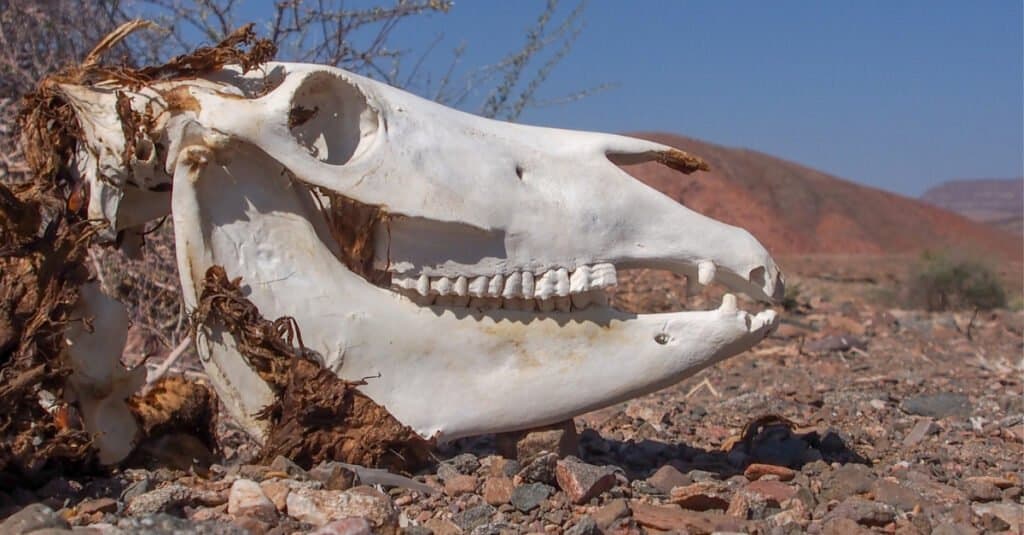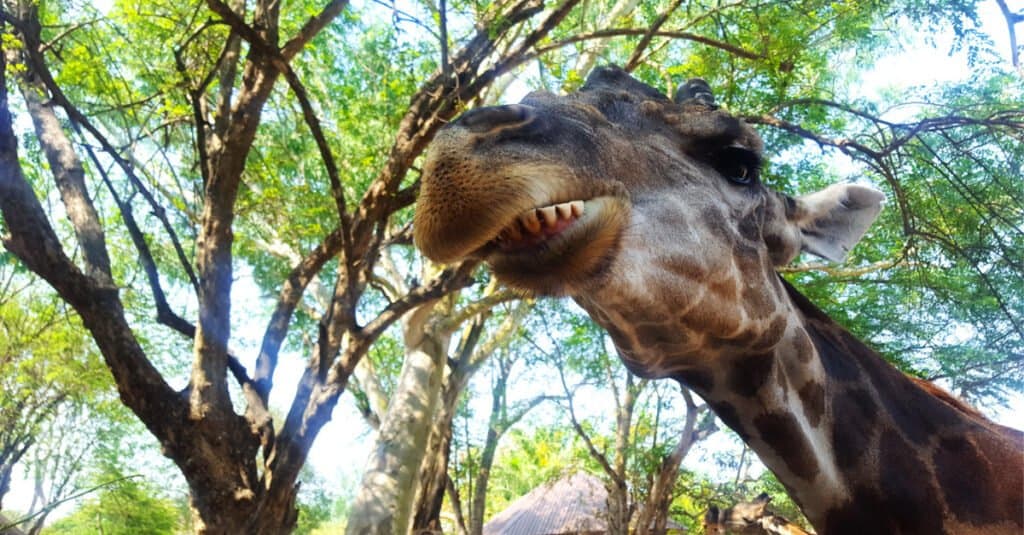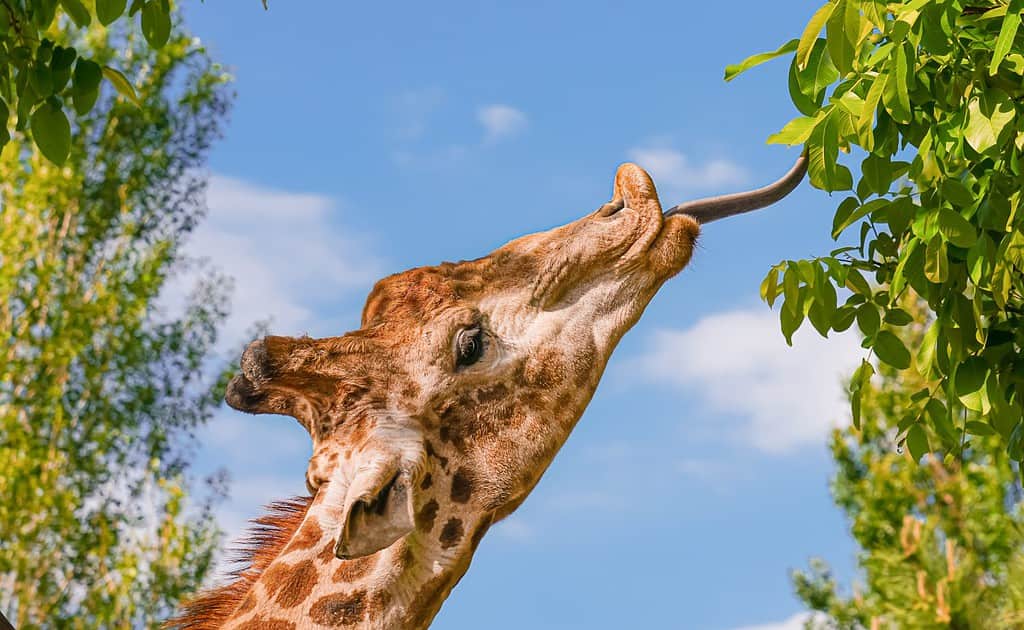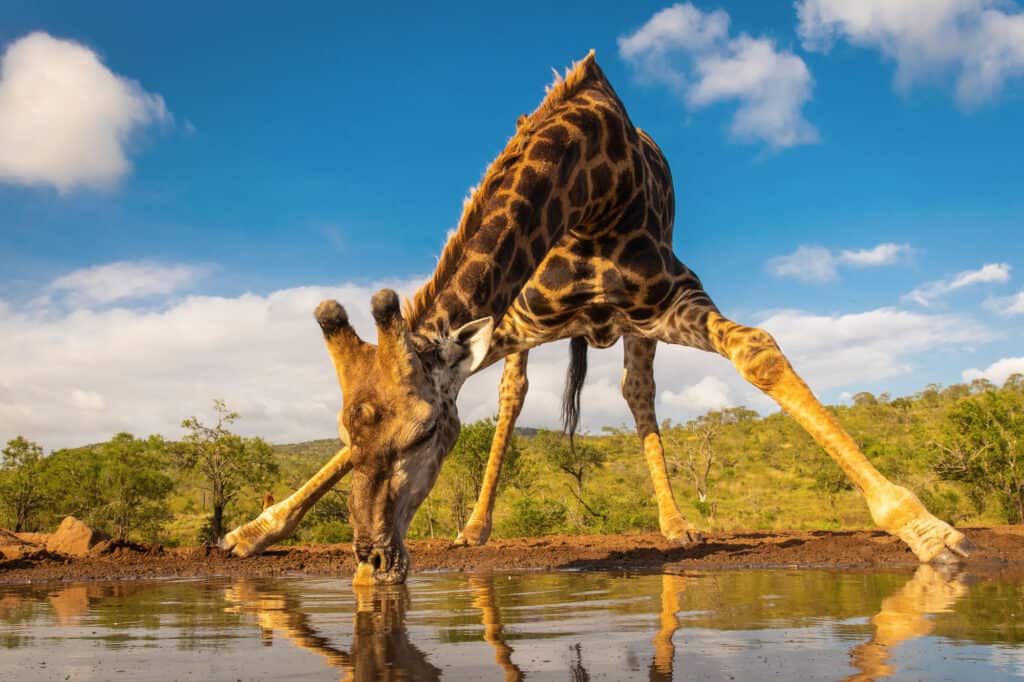
The post Giraffe Teeth Are Just Like Ours—With One Bizarre Twist appeared first on A-Z Animals.
Giraffes are known for their long, impressive tongues, but they have a cool set of teeth in their mouths as well. Even though giraffes are huge — they are the tallest land animals, after all — they have the same number of teeth as humans do: 32! This is one of the only similarities between giraffe teeth and human teeth, though.
Anatomy of a Giraffe Jaw

Most of a giraffe’s teeth are located in the back of its mouth.
©iStock.com/Fearless on Four Wheels
Peek inside a giraffe’s mouth, and you might find something surprising: they have no front teeth at the top of their jaw. Instead, a lump of hard tissue called a hard plate or dental pad provides extra strength, which they need to pull leaves off trees and grind food before swallowing.
They don’t need front teeth because giraffes grab leaves and twigs with their mouths and quickly swallow them. Later, they regurgitate the partially digested food up their 6-to-8-foot-long necks to chew it again in a process called chewing cud, according to the San Diego Zoo. While it may sound unappealing, chewing cud is normal for ruminant animals like cows and helps keep their teeth clean. Once they are done (they may chew on it for hours!), they swallow the chewed cud, which then completes digestion in a different chamber of the stomach. In fact, giraffes can eat approximately 75 pounds of leaves per day, and their four stomach chambers handle different functions of digestion.
What Do Their Teeth Look Like?

Giraffes have molars and incisors, which look much like humans’ teeth but are bigger.
©iStock.com/Yuliya
Like their necks, their teeth are also extra-long. The majority of a giraffe’s teeth are molars located in the back of their mouths, which are big, flat, and strong for chewing a variety of plants. Giraffes also have sharp and strong incisors, designed for cutting up food and stripping vegetation off bushes. In addition to missing upper front teeth, giraffes have a large gap (called a diastema) between their lower front teeth and their back teeth, making their skulls quite unique. When eating, a giraffe uses its tongue and lips to grip leaves, then pulls its head back to strip the foliage from the branch before moving the food to the back of its mouth to be chewed.
How Teeth Indicate Age

Giraffes will lose a set of baby teeth just like humans!
©Snehasis Panja/Shutterstock.com
Researchers have determined in a 1976 study that there are 13 unique stages of tooth eruption in giraffes, which can be used to figure out the animal’s approximate age. Like humans, giraffes have baby teeth that they will eventually lose as they grow older, to be replaced with a permanent set of adult teeth. The Denver Zoo shared pictures on Facebook of one of their baby giraffes named Dobby, who lost two of his baby teeth just before turning 3. “This not-so-little man recently lost two of his baby teeth and was visited by the tooth fairy (who looked suspiciously like a Zookeeper) with gifts of carrots, lettuce, and other tasty treats,” the zoo captioned the cool post. “His mature teeth are growing in fast—another step on the road to adulthood!”
Giraffe Tongues

Many features in a giraffe allow them to forage for food at the tops of trees.
©marseus/Shutterstock.com
It’s not just their teeth that are unique. Giraffes’ tongues are 45-50 cm long, sticky, and dexterous, which helps them grip leaves, flowers, and fruits. Their tongues have thickened papillae and their saliva is extra thick too, which helps protect their mouths from thorns. This is especially helpful because one of their favorite trees, the Acacia, has thorns that grow up to 3 inches long.
Another interesting fact: giraffe tongues are black, blue, or purple with a pink base. Some experts believe this darker color protects giraffes from sun exposure while eating — after all, their tongues are much closer to the sun than any other animal. Additionally, they can tilt their necks up due to a special ball-and-socket joint that connects the top vertebra of their spine with their skull. This allows them to rotate their nose to rub against their back or tilt their head up at an increased angle to forage for food.
Water? No Thanks!

Giraffes will bend their knees to drink water from the ground, putting them in a vulnerable position for predators.
©Wim Hoek/Shutterstock.com
Unlike humans, giraffes don’t need to drink water every day — or even most days. These impressive mammals can go several days to a week without drinking water because they stay hydrated through the water contained in the acacia leaves they eat. When they do drink, they can consume as much as 10 gallons in one go! Giraffes are among the most distinctive creatures on the planet, from their unusually long necks to the unique structure of their mouths.
The post Giraffe Teeth Are Just Like Ours—With One Bizarre Twist appeared first on A-Z Animals.
June 11, 2025 at 12:02AMSydni Ellis
.jpeg)
.jpeg)

0 Comments